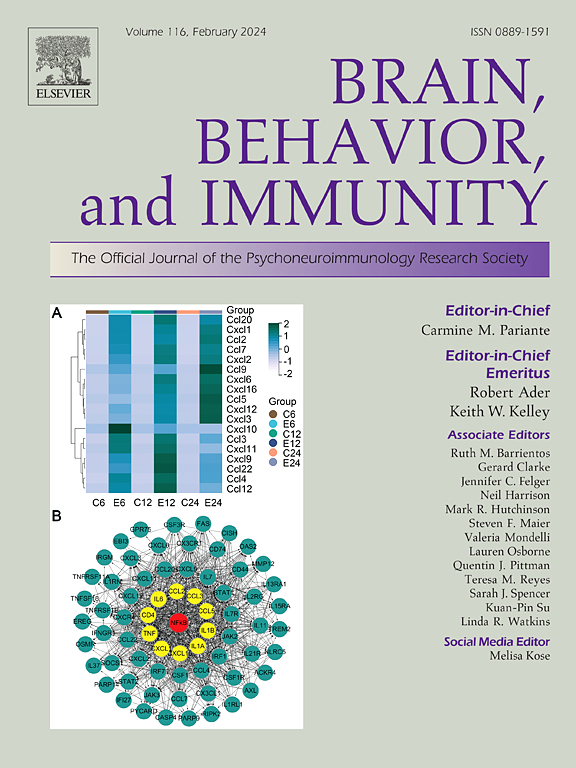Ezrin-mediated astrocyte-synapse signaling regulates cognitive function via astrocyte morphological changes in fine processes in male mice
IF 8.8
2区 医学
Q1 IMMUNOLOGY
引用次数: 0
Abstract
Astrocytes, which actively participate in cognitive processes, have a complex spongiform morphology, highlighted by extensive ramified fine processes that closely enwrap the pre- and post-synaptic compartments, forming tripartite synapses. However, the role of astrocyte morphology in cognitive processes remains incompletely understood and even controversial. The actin-binding protein Ezrin is highly expressed in astrocytes and is a key structural determinant of astrocyte morphology. Here, we found that Ezrin expression and astrocyte fine process volume in the hippocampus of male mice increased after learning but decreased after lipopolysaccharide injection and in a mouse model of postoperative cognitive dysfunction, both of which involved models with impaired cognitive function. Additionally, astrocytic Ezrin knock-out led to significantly decreased astrocytic fine process volumes, decreased astrocyte-neuron proximity, and induced anxiety-like behaviors and cognitive dysfunction. Astrocytic Ezrin deficiency in the hippocampus was achieved by using a microRNA silencing technique delivered by adeno-associated viruses. Down-regulation of Ezrin in hippocampal astrocytes led to disrupted astrocyte-synapse interactions and impaired synaptic functions, including synaptic transmission and synaptic plasticity, which could be rescued by exogenous administration of D-serine. Remarkably, decreased Ezrin expression and reduced astrocyte fine processes volumes were also observed in aged mice with decreased cognitive function. Moreover, overexpression of astrocytic Ezrin increased astrocyte fine process volumes and improved cognitive function in aged mice. Overall, our results indicate Ezrin-mediated astrocyte fine processes integrity shapes astrocyte-synapse signaling contributing to cognitive function.
Ezrin介导的星形胶质细胞-突触信号通过星形胶质细胞形态学变化调节雄性小鼠精细过程中的认知功能。
积极参与认知过程的星形胶质细胞具有复杂的海绵状形态,突出表现为广泛的分支细小过程,紧密包裹突触前后区,形成三方突触。然而,人们对星形胶质细胞形态在认知过程中的作用仍不甚了解,甚至存在争议。肌动蛋白结合蛋白 Ezrin 在星形胶质细胞中高度表达,是星形胶质细胞形态的关键结构决定因素。在这里,我们发现雄性小鼠海马中的 Ezrin 表达和星形胶质细胞精细过程体积在学习后增加,但在注射脂多糖后和小鼠术后认知功能障碍模型中减少,这两种模型都涉及认知功能受损模型。此外,敲除星形胶质细胞 Ezrin 会导致星形胶质细胞精细过程体积显著减少,星形胶质细胞与神经元的接近性降低,并诱发焦虑样行为和认知功能障碍。利用腺相关病毒传递的微RNA沉默技术实现了海马星形胶质细胞Ezrin的缺失。下调海马星形胶质细胞中的Ezrin会导致星形胶质细胞与突触间的相互作用紊乱,并损害突触功能,包括突触传递和突触可塑性。值得注意的是,在认知功能下降的老年小鼠中也观察到 Ezrin 表达减少和星形胶质细胞精细过程体积缩小。此外,过表达星形胶质细胞 Ezrin 可增加星形胶质细胞精细过程体积,改善老年小鼠的认知功能。总之,我们的研究结果表明,Ezrin 介导的星形胶质细胞精细过程完整性塑造了有助于认知功能的星形胶质细胞-突触信号转导。
本文章由计算机程序翻译,如有差异,请以英文原文为准。
求助全文
约1分钟内获得全文
求助全文
来源期刊
CiteScore
29.60
自引率
2.00%
发文量
290
审稿时长
28 days
期刊介绍:
Established in 1987, Brain, Behavior, and Immunity proudly serves as the official journal of the Psychoneuroimmunology Research Society (PNIRS). This pioneering journal is dedicated to publishing peer-reviewed basic, experimental, and clinical studies that explore the intricate interactions among behavioral, neural, endocrine, and immune systems in both humans and animals.
As an international and interdisciplinary platform, Brain, Behavior, and Immunity focuses on original research spanning neuroscience, immunology, integrative physiology, behavioral biology, psychiatry, psychology, and clinical medicine. The journal is inclusive of research conducted at various levels, including molecular, cellular, social, and whole organism perspectives. With a commitment to efficiency, the journal facilitates online submission and review, ensuring timely publication of experimental results. Manuscripts typically undergo peer review and are returned to authors within 30 days of submission. It's worth noting that Brain, Behavior, and Immunity, published eight times a year, does not impose submission fees or page charges, fostering an open and accessible platform for scientific discourse.

 求助内容:
求助内容: 应助结果提醒方式:
应助结果提醒方式:


